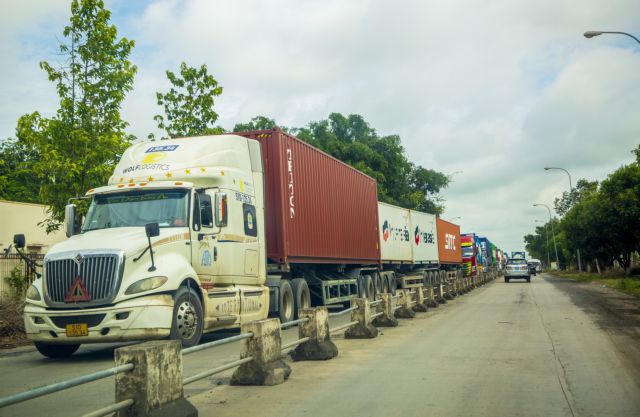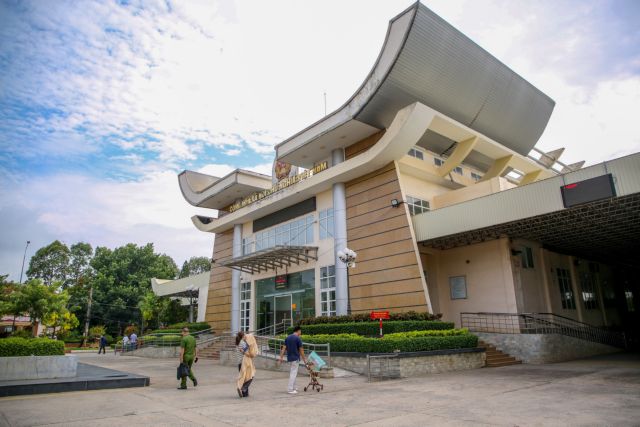 Economy
Economy


|
| Lorries queue in long lines for infrastructure fee payment at Mộc Bài International Border Gate in Tây Ninh Province. VNA/VNS Photo |
TÂY NINH — Long seen as a strategic node on the Việt Nam–Cambodia border, the Mộc Bài Border Gate Economic Zone in Tây Ninh Province is undergoing a policy reorientation that may finally unlock its full potential.
With its prime location on the Southern Economic Corridor of the Greater Mekong Subregion, Mộc Bài is now the subject of renewed ambition, as provincial authorities seek central Government approval for special mechanisms to transform it into a modern economic and logistics hub.
Tây Ninh Province lies at the heart of the Southern Key Economic Region, sharing more than 368 kilometres of border with the Cambodian provinces of Svay Rieng, Pray Veng and Tboung Khmum.
The province operates four international border gates, four national gates, and 13 auxiliary crossings, making it a crucial player in Việt Nam’s border economy.
Mộc Bài, located along the Trans-Asia Highway, is the largest land border gate in southern Việt Nam.
Established over two decades ago, the zone was envisioned as a model of socio-economic development for border areas, intended to boost trade with Cambodia and enhance connectivity with ASEAN neighbours.
It was among the first economic zones of its kind in the country, offering a vital land link to regional markets.
Despite this vision, the development of Mộc Bài has fallen short of expectations.
Of the 1,797 hectares earmarked for projects, only around 15 per cent has been effectively utilised.
While infrastructure such as the HCM City – Mộc Bài Expressway and regional ring roads are under development, land clearance issues and a lack of consistent investment incentives have slowed progress.
The removal of tax exemptions in 2015 significantly dampened commercial activity in the zone, further discouraging investment.
Meanwhile, across the border, Cambodia has been aggressively pursuing foreign investment with attractive incentives in its adjacent economic zones.
These policies have drawn significant FDI from China, South Korea, Singapore and Thailand, placing competitive pressure on Mộc Bài.
As of March 2025, the economic zone had attracted 60 projects, including 26 FDI projects and 34 domestic ones, with total registered capital of VNĐ8.5 trillion (approximately US$334 million) and US$470.78 million, respectively.
However, state-funded infrastructure investment remains limited, totalling just VNĐ991.8 billion (around $39 million).
Special mechanisms needed
Recognising these limitations, the People’s Committee of Tây Ninh has submitted a proposal to the Central Government for the piloting of special policies to revitalise Mộc Bài.
According to Trương Văn Liếp, Director of the provincial Department of Finance, the aim is to make the zone more attractive to strategic investors and to enhance integration with the wider Mekong sub-region and Southeast Asia.
The proposed vision is rooted in a shift towards a green, sustainable and innovative model of development.
Authorities intend to transform Mộc Bài into a modern complex of industry, urban services and logistics, governed by an advanced regulatory framework.
The emphasis will be on attracting large enterprises and long-term investors capable of executing high-value projects.
The proposed policies include preferential treatment for strategic investors, particularly in sectors such as innovation centres, high-end tourism, integrated entertainment and urban services.
Investors would be selected based on financial strength and a demonstrated ability to deliver similar large-scale projects.
In return, they would be required to commit to capital disbursement within five years and contribute to land clearance, compensation and resettlement funding.
Tây Ninh also seeks decentralisation in planning decisions. For areas under 500 hectares that do not significantly alter the province’s urban development orientation, the proposal would allow the Chairman of the provincial People’s Committee to approve adjustments to general construction planning, following the Prime Minister’s approval in principle.
Preferential policies
The proposal also focuses on policies to attract skilled human resources.
Tây Ninh has suggested visa-free entry for foreign tourists visiting Mộc Bài for stays of up to 30 days.
For foreign workers employed in the economic zone, visa and work permit requirements would be waived for five years, with options for renewal.
Additionally, such workers would be eligible to purchase social housing units within the zone, enhancing their long-term commitment and quality of life.
Another significant request is to retain 100 per cent of revenue normally remitted to the central budget—including import-export tax revenues—for reinvestment in the economic zone’s infrastructure.
This, the province argues, is essential for accelerating development and overcoming long-standing constraints on funding.

|
| Travellers enter Việt Nam from Cambodia through Mộc Bài International Border Gate in Tây Ninh Province. VNA/VNS Photo |
Infrastructure boost and future outlook
According to Nguyễn Nam Hưng, Director of the provincial Department of Construction, the general zoning plan for Mộc Bài has already been approved by the Prime Minister and is soon to be officially announced.
In parallel, major infrastructure projects such as the HCM City – Mộc Bài Expressway, Ring Roads 3 and 4, and the provincial route ĐT 827E are progressing steadily.
These projects are expected to significantly improve connectivity, reduce logistics costs, and enhance the competitiveness of exports and imports through the border gate.
Nguyễn Văn Út, Chairman of the Tây Ninh People’s Committee, affirmed that the province has instructed its departments to finalise the zoning plan for the economic zone.
He added that Tây Ninh would continue to petition for the application of special mechanisms and urged careful planning of funding sources—public, private, and central budget—for inclusion in the medium-term public investment plan for 2026–2030.
With the right mechanisms in place and strategic investment in infrastructure and governance, the Mộc Bài Border Gate Economic Zone could evolve into a dynamic centre for international trade, cross-border cooperation, and regional security.
The coming years will be decisive in determining whether the long-anticipated potential of Mộc Bài is finally realised. — VNS




